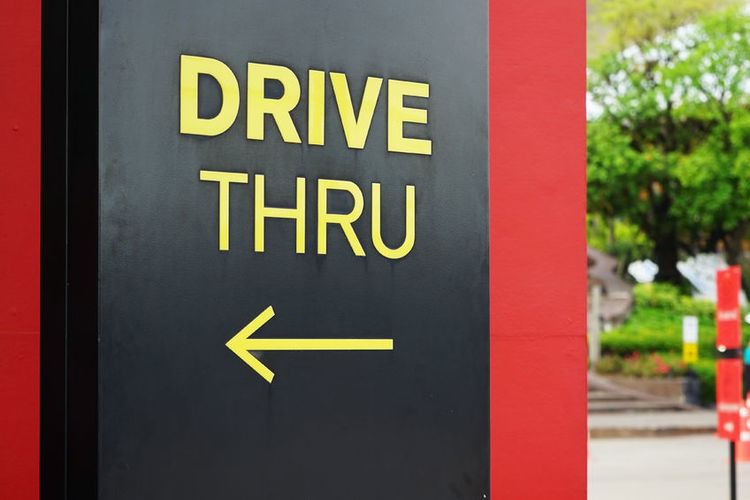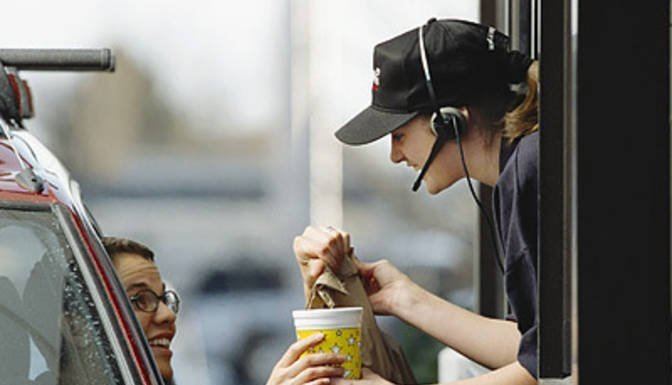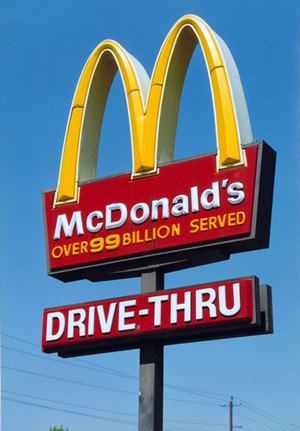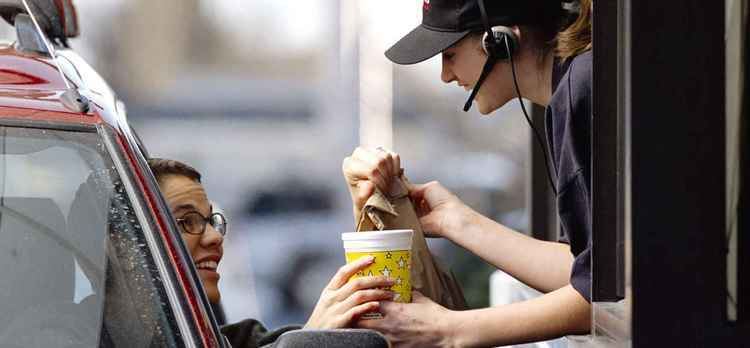 | ||
A drive-through, or drive-thru, is a type of service provided by a business that allows customers to purchase products without leaving their cars. The format was pioneered in the United States in the 1930s by Jordan Martin, but has since spread to other countries. The first recorded use of a bank using a drive-up window teller was the Grand National Bank of St. Louis, Missouri in 1930. The drive-up teller allowed only deposits at that time.
Contents
- Examples
- Restaurants
- McDonalds
- Max burger
- Banking
- Grocery shopping
- Non car usage
- Walk up windows
- Ski through
- References

Orders are generally placed using a microphone and picked up in person at the window. A drive-through is different from a drive-in in several ways - the cars create a line and move in one direction in drive-throughs, and normally do not park, whereas drive-ins allow cars to park next to each other, the food is generally brought to the window by a server, called a carhop, and the customer can remain in the parked car to eat. However, during peak periods, to keep the queue down and avoid traffic-flow problems, drive-throughs occasionally switch to an "order at the window, then park in a designated space" model where the customer will receive their food from an attendant when it is ready to be served. This results in a perceived relationship between the two service models.

Drive-throughs have generally replaced drive-ins in popular culture, and are now found in the vast majority of modern American fast-food chains. Sometimes, a store with a drive-through is referred to as a "drive-through," or the term is attached to the service, such as, "drive-through restaurant," or "drive-through bank."

Drive-throughs typically have signs over the drive-through lanes to show customers which lanes are open for business. The types of signage used is usually illuminated so the "open" message can be changed to a "closed" message when the lane is not available.

Examples

Restaurants
A drive-through restaurant generally consists of:
Drive-through designs are different from restaurant to restaurant; however, most drive-throughs can accommodate four to six passenger cars or trucks at once (called the queue). Most drive-through lanes are designed so the service windows and speaker are on the driver's side of the car, for example, in left-hand traffic (right-hand drive) countries such as the UK, Ireland, Australia and New Zealand, the windows will be on the right side of the drive-through lane, and vice versa in right-hand traffic (left-hand drive) countries such as North America and mainland Europe. There are a few drive-through lanes designed with the service windows on the passenger side, but these lanes are disfavored as they cannot be used easily by cars with only a driver.
According to author Michael Karl Witzel, drive-through windows were a method first tested as far back as 1931 by the Texas Pig Stand chain. The first drive-through restaurant was created in 1947 by Sheldon "Red" Chaney, operator of Red's Giant Hamburg in Springfield, Missouri. Located on the famous Route 66, the restaurant served customers until its closure in 1984. Several other companies lay claim to having invented the first restaurant of this kind, including the In-n-Out Burger chain, which didn't open a drive-through until 1948. Maid-Rite also claims to have had the first drive-through window. Other sources cite Jack in the Box as the first major restaurant specifically designed as a drive-through and featuring a two-way intercom. The first Jack in the Box opened in 1951 in San Diego. The drive-through concept was so unfamiliar to people at the time that the Jack in the Box "clown," where the speaker was housed, held a sign saying, "Pull forward, Jack will speak to you."
However, according to Michael Wallis, author of Route 66: The Mother Road, Red's Giant Hamburg in Springfield, Missouri is home to "the world's first drive-through window".
McDonald's
Sierra Vista, Arizona, was the first city to have a McDonald's drive-through. The first McDonald's drive-through was created in 1975 near Fort Huachuca, a military installation located adjacent to the city—to serve military members who weren't permitted to get out of their cars while wearing fatigues. The original McDonald's was closed down and demolished in May 1999 and a new McDonald's replaced it.
In 2010, the Casa Linda, Texas, franchise opened a drive-through/walk-up only store with no indoor seating although it has small patio with tables. The same company operates a walk-up only store front next to the West End Station of DART Rail.
The first drive-through restaurant (a McDonald's drive-through) in Europe opened at the Nutgrove Shopping Centre in Dublin, Ireland in 1985.
In Spain and Russia, McDonald's drive-through services are often called McAuto.
In the Netherlands, Germany, France, Portugal, Italy and other northern European countries, McDonald's drive-through service is called McDrive.
In Chile, Argentina and Mexico, McDonald's drive-through service is called AutoMAC.
Max burger
1981 Max Hamburgers opens Northern Europe's first drive-in in Piteå.
Banking
In 1928, City Center Bank, which became UMB Financial Corporation, president R. Crosby Kemper opened what is considered the first drive-up window. Shortly after the Grand National Bank in St Louis opened up a drive-through, including a slot to the side for night time deposits. Westminster Bank opened the UK's first drive-through bank in Liverpool in 1959, soon followed by Ulster Bank opening Ireland's first in 1961 at Finaghy.
In recent years, there has been a decline in drive-through banking due to increased traffic congestion and the increased availability of automated teller machines and telephone and Internet banking. However, many bank buildings now feature drive-through ATMs.
Grocery shopping
Harold Willis and his father, Robert Willis, first incorporated a dairy and eggs drive through service in Redlands, California, in the early 1940s, supplying milk and eggs quickly and efficiently to driving customers; this utilized a dairy conveyor belt that Harold Willis had invented. Some supermarkets offer drive-through facilities for grocery shopping. In the UK, this service was first announced by Tesco in August 2010. And in the United States, Crafty's Drive-Buy Grocery Store in Virginia started offering the service. In 2012, the Dutch chain Albert Heijn introduced a "Pick Up Point" where one can collect groceries bought online.
Non-car usage
Pedestrians sometimes attempt to walk through the drive-through to order food after the seated section of a fast-food restaurant has closed. Many establishments refuse drive-through service to pedestrians for safety, insurance, and liability reasons. Cyclists are usually refused service with the same justification given. However, in the summer of 2009, Burgerville gave use of the drive-through window to bicyclists. Similar issues can arise in rural areas for people on horseback or in a horse-drawn carriage.
On 20 July 2013, a woman was fined for taking her horse inside a McDonald's restaurant in Greater Manchester, United Kingdom after being refused service at the drive-through. The horse ended up defecating inside the restaurant which caused distress to other customers.
Walk-up windows
Some establishments provide a walk-up window instead when a drive-through may not be practical. However, the walk-up windows should not be confused with small establishments that customers are lined up for services such as mobile kitchens, kiosks or concession stands. These walk-up windows are value-added services on top of the full services provided inside the stores.
The walk-up windows generally provide similar customer experience with the drive-throughs by allowing customers to receive services from the exterior of the facilities through a window. There are many reasons for the owners to provide such services. An example is when McDonald's entered a new market in Russia where the majority of families didn't own cars, the owners developed the walk-up windows as an alternative. Another reason is to have a drive-through experience in the locations that are not feasible to construct a drive-through lane such as in city centers. Some establishments may want to use walk-up windows to attract certain customer demographics such as younger customers who need quick services during late night. Also another reason is to offer extended service hours and maintain a safe environment for employees such as a bulletproof walk-up window of convenience stores in high-crime areas.
Ski-through
McDonald's first opened a ski-through called 'McSki in Sweden's ski resort of Lindvallen in 1996.
